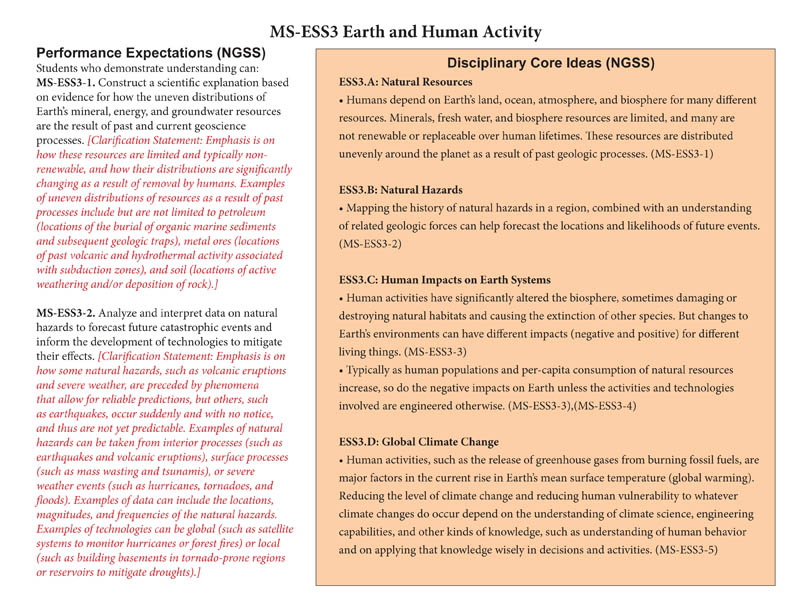

_________________________________________________________________________________________________________________________________________________________
Disciplinary Core Ideas
ESS3.A: Natural Resources
• Humans depend on Earth’s land, ocean, atmosphere, and biosphere for many different resources. Minerals, fresh water, and biosphere resources are limited, and many are not renewable or replaceable over human lifetimes. These resources are distributed unevenly around the planet as a result of past geologic processes. (MS-ESS3-1)
ESS3.B: Natural Hazards
• Mapping the history of natural hazards in a region, combined with an understanding of related geologic forces can help forecast the locations and likelihoods of future events. (MS-ESS3-2)
_________________________________________________________________________________________________________________________________________________________
Use the Template and Resource Links to Fulfill NGSS
l. Goals:
Essential Questions:
NGSS Note: Think, question, entertain ideas.
ll. Introductory Activities to Assess Prior Knowledge
A. Simple Activities - that assess your students’ understanding of Natural Resources and Natural Hazards.
BSimple Activities - that assess students’ understanding of how we predict and protect from natural hazards.
C. Brainstorming Session
Question: How are we affecting Earth's resources (water, land, air)?
1. Break students down into groups of 3-4.
2. Ask students to generate a list of the different ways humans are affecting Earth's resources (including climate).
3. Discuss
lll. New Knowledge - Text
Read about Earth's resources and how humans affect them.
Read about Earth's natural hazards and how we try to protect ourselves from them.
Storms - Hurricanes (Basic Readers)
Storms - Thunderstorms (Basic Readers)
Storms - Tornadoes (Basic Readers)
Examples of Models (depicts the concepts expressed in the reading):
Ask students to look at the two models illustrating global warming and climate change and explain how each illustrates the concept.
V. Summarize Knowledge - Enduring Understandings
Vl. Next Generation of Science Standards (NGSS) - Middle School Earth Science
Disciplinary Core Ideas
ESS3.A: Natural Resources
• Humans depend on Earth’s land, ocean, atmosphere, and biosphere for many different resources. Minerals, fresh water, and biosphere resources are limited, and many are not renewable or replaceable over human lifetimes. These resources are distributed unevenly around the planet as a result of past geologic processes. (MS-ESS3-1)
ESS3.B: Natural Hazards
• Mapping the history of natural hazards in a region, combined with an understanding of related geologic forces can help forecast the locations and likelihoods of future events. (MS-ESS3-2)
Science and Engineering Practices
Asking Questions and Defining Problems
Asking questions and defining problems in grades 6–8 builds on grades K–5 experiences and progresses to specifying relationships between variables, and clarifying arguments and models.
• Ask questions to identify and clarify evidence of an argument. (MS-ESS3-5)
Analyzing and Interpreting Data
Analyzing data in 6–8 builds on K–5 and progresses to extending quantitative analysis to investigations, distinguishing between correlation and causation, and basic statistical techniques of data and error analysis.
• Analyze and interpret data to determine similarities and differences in findings. (MS-ESS3-2)
Constructing Explanations and Designing Solutions
• Constructing explanations and designing solutions in 6–8 builds on K–5 experiences and progresses to include constructing explanations and designing solutions supported by multiple sources of evidence consistent with scientific ideas, principles, and theories.
• Construct a scientific explanation based on valid and reliable evidence obtained from sources (including the students’ own experiments) and the assumption that theories and laws that describe the natural world operate today as they did in the past and will continue to do so in the future. (MS-ESS3-1)
• Apply scientific principles to design an object, tool, process or system. (MS-ESS3-3)
Engaging in Argument from Evidence
Engaging in argument from evidence in 6–8 builds on K–5 experiences and progresses to constructing a convincing argument that supports or refutes claims for either explanations or solutions about the natural and designed world(s).
• Construct an oral and written argument supported by empirical evidence and scientific reasoning to support or refute an explanation or a model for a phenomenon or a solution to a problem. (MS-ESS3-4)
Crosscutting Concepts
Patterns
• Graphs, charts, and images can be used to identify patterns in data. (MS-ESS3-2)
Cause and Effect
• Relationships can be classified as causal or correlational, and correlation does not necessarily imply causation. (MS-ESS3-3)
• Cause and effect relationships may be used to predict phenomena in natural or designed systems. (MS-ESS3-1),(MS-ESS3-4)
Stability and Change
• Stability might be disturbed either by sudden events or gradual changes that accumulate over time. (MS-ESS3-5)
Connections to Engineering, Technology and Applications of Science
Influence of Science, Engineering, and Technology on Society and the Natural World
• All human activity draws on natural resources and has both short and long-term consequences, positive as well as negative, for the health of people and the natural environment. (MS-ESS3-1),(MS-ESS3-4)
• The uses of technologies and any limitations on their use are driven by individual or societal needs, desires, and values; by the findings of scientific research; and by differences in such factors as climate, natural resources, and economic conditions. Thus technology use varies from region to region and over time. (MS-ESS3-2),(MS-ESS3-3)
When you research information you must cite the reference. Citing for websites is different from citing from books, magazines and periodicals. The style of citing shown here is from the MLA Style Citations (Modern Language Association).
When citing a WEBSITE the general format is as follows.
Author Last Name, First Name(s). "Title: Subtitle of Part of Web Page, if appropriate." Title: Subtitle: Section of Page if appropriate. Sponsoring/Publishing Agency, If Given. Additional significant descriptive information. Date of Electronic Publication or other Date, such as Last Updated. Day Month Year of access < URL >.
Amsel, Sheri. "ESS3.A: Natural Resources and ESS3.B: Natural Hazards (MS-ESS3: Earth and Human Activity)" Exploring Nature Educational Resource ©2005-2024. December 15, 2024
< http://exploringnature.org/db/view/ESS3A-Natural-Resources-and-ESS3B-Natural-Hazards-MS-ESS3-Earth-and-Human-Activity >

